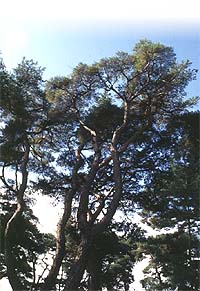Korean Pine Tree |
|
| There is a saying which says that we all are born in a pine tree, live in a pine tree, and die in a pine tree. Traditionally, when a child was born, a rope was hung across the main gate to prevent evil spirits and unwanted visitors from entering the home. Pine twigs and needles were attached to this rope to protect the baby. Traditional homes were made of pine.
People heated their homes with pine branches, cooked with pine bark, and used pine pollen in cooking. When they died, they were placed in pine caskets and buried on hills covered with pine trees. It is no exaggeration to say that Koreans lived in a pine tree culture, while Europeans traditionally lived in a birch culture and the Japanese in a verdant subtropical forest culture. Koreans consider the pine a noble tree for it remains green all winter, a model of steadfastness and integrity. |
 |
|
In traditional paintings and poetry, the pine was one of the ten longevity symbols. In modern Korea, the pine tree remains an important symbol. The national anthem refers to the tree as a symbol of fortitude in the midst of hardship. Traditional Korean furniture items are often made out of pine wood.
|
|

